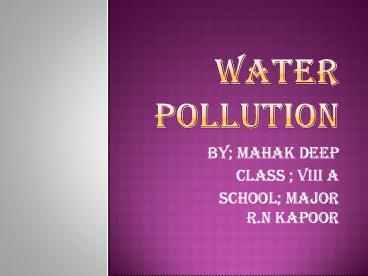water pollution - PowerPoint PPT Presentation
Title:
water pollution
Description:
this is a use full ppt on water pollution – PowerPoint PPT presentation
Number of Views:1020
Title: water pollution
1
Water Pollution
- BY MAHAK DEEP
- class viii a
- school major r.n kapoor
2
OUTLINE
- Introduction
- Water subject to pollution
- Pollutants
- Domestic Policy
- Development of regime
- Land-based Sources
- Dumping
- Pollution from Ships
- Liability
- Conclusion
3
Introduction
- Two types of water subject to pollution
- Surface water rivers, lakes, oceans
- Uses drinking, recreational fishing, boating,
swimming, irrigation. - Groundwater- occurs beneath a water table in
soils or rocks subject to pollution from toxic
chemicals. - Uses drinking, irrigation, etc
4
- Contamination
- Nature of sources of contamination point and
non-point - Point source discharge into surface waters at a
specific location through a pipe, outfall or
ditch.
5
- Sources of contamination
- For Groundwater
- -polluting substances leach into a
water-saturated region e.g. toxic chemicals - -Mainly due to migration of pollutants from
sites with high concentrations of chemicals
e.g. industrial waste sites and farms
6
- Sources of contamination
- For Surface water
- Rivers and lakes
- Point source -sewage municipal or private
- - industrial wastes
- Non-point source
- Agricultural activity e.g. pesticides,
fertilizers. - urban and highway water runoff.
- Ocean oil spills, dumping, land-based sources
- Oil spills during transportation, either
accidentally or intentionally - Dumping sewage, chemical disposal, radioactive
materials - Land-based sources migration of chemical
substances.
7
Types of Pollutants Fund and accumulating
pollutants
- I) Fund pollutants
- -Environment has some assimilative capacity. If
capacity for absorption higher than rate of
injection, they may not accumulate. - a) Degradable
- degrades/break into component parts within water.
Are normally organic residuals attacked and
broken down by bacteria and become less harmful. - b) Thermal pollution
- caused by injection of heat into watercourses by
an industrial plant or electric utility using
surface water as a coolant, and returning the
heated water to the watercourse.
8
Domestic policy on international waters Ocean
- I) Oil spills covered under the Clean Water
Act - prohibits discharges of harmful quantities of oil
into navigable waters - industry assume responsibility for any damage
clean up compensation for environmental
restoration. - II) Dumping
- Marine Protection Research and Sanctuaries Act,
1972. - address discharges of waste
- within U.S. territorial limits
- by U.S. vessels or persons in any ocean waters.































